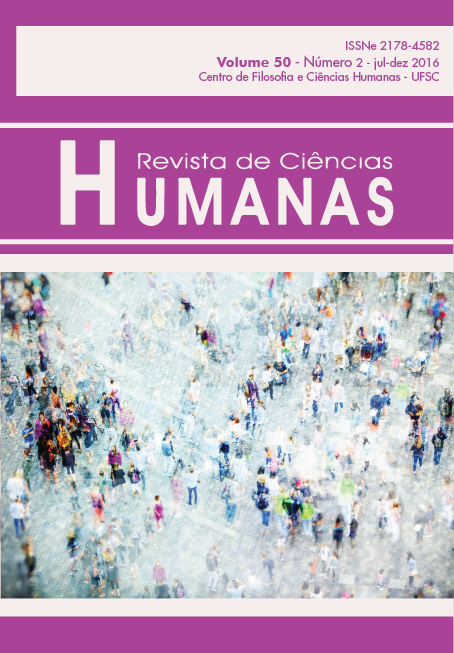Um mergulho no “Morro do Querosene” e o encontro com os artistas do invisível: reflexões sobre arte, comunidade, afeto e práxis psicossocial
DOI:
https://doi.org/10.5007/2178-4582.2016v50n2p315Resumo
Trata-se de uma reflexão sobre arte e comunidade, com foco na análise das afetações que a cultura popular promove em um bairro. Vigotski é autor de referência, com sua defesa do psicológico como fenômeno sócio-histórico, da positividade dos afetos e da concepção de arte como a linguagem das emoções. As reflexões partem de pesquisa realizada no “Morro do Querosene”, situado na cidade mais populosa e de maior poder aquisitivo do Brasil, que possui uma história marcada pela arte e cultura. Elas evidenciam que a cultura popular , quando realizada na rua, promove encontros que favorecem configurações comunitárias, paralelamente à explicitação das contradições e relações de poder que permeiam o cotidiano dos moradores. Os relatos de dois mestres de expressões culturais diferentes, bumba meu boi e capoeira, sugerem que é possível fazer a vida pessoal e urbana por outras vias, oferecendo subsídios à práxis psicossocial potencializadora do agir em comum.
Referências
REFERÊNCIAS BIBLIOGRÁFICAS
(Mestrado em Psicologia Social) – Dissertação– Pontifícia Universidade Católica de São Paulo: SANTOS, L. M. Dos encontros com cultura popular no Morro do Querosene: um estudo do movimento bairro/comunidade. 2015. 103f.
AURELIO, D.P. In: Spinoza, Benedictus de, 1632-1677. Tratado político; tradução, introdução, notas Diogo Pires Aurélio; revisão da tradução Homero Santiago. - São Paulo: Editora WMF Martins Fontes, 2009.
CHAUÍ, M. Conformismo e resistência: Aspectos da cultura popular no Brasil. São Paulo: Editora Brasiliense, 1.986.
ESPINOSA, B. Ética. Belo Horizonte: Autentica, 2010. Tradução de Thomaz Tadeu.
FREIRE, R. Viva eu, viva tu, viva o rabo do tatu. É luta, é dança, é capoeira. 6ªedição: Fevereiro, 1986-Global Editora.
KAPLAN, A. O processo social e o profissional de desenvolvimento. Artistas do Invisível (Série Tornamento); Tradução de Ana Paula Pacheco Chaves Giorgi. – São Paulo: Instituto Fonte para o Desenvolvimento Social e Editora Fundação Petrópolis, 2005.
OLIVEIRA, B. A dialética do singular-particular-universal. In: ABRANTES, Angelo Antonio; SILVA, Nilma Renildes da; MARTINS, Sueli Terezinha Ferreira; Método Histórico-Social na Psicologia Social – Vozes, 2005. ISBN 85, 326,3129-0.
PARKER, I. Revolução na psicologia. Campinas ed,Alínea , 2014
RANCIERE, J. O Dissenso. In: A Crise da Razão. São Paulo: Companhia das Letras: Brasília, DF: Ministério da Cultura: Rio de Janeiro: Fundação Nacional de Arte, 1996.
SAWAIA, B.B. Introduzindo a afetividade na reflexão sobre estética, imaginação e constituição do sujeito In DA ROS, S.; Maheirie,K e Zanella, A. (Orgs.) Relações estéticas, atividade criadora e imaginação: sujeitos e (em)experiência Florianópolis: NUP/CED/UFSC, 2006
______________. Comunidade: A apropriação científica de um conceito tão antigo quanto a humanidade. In: Psicologia Social Comunitária: da solidariedade à autonomia. Petrópolis, RJ: Vozes, 2009, 15°ed.
VIGOTSKI, L.S Manuscrito de 1929. Educ. Soc.,Campinas , v. 21,n. 71, p. 21-44,Jul 2000 . Disponível em:<http://www.scielo.br/scielo.php?script=sci_arttext&pid=S0101-73302000000200002>. Acesso em 04 Mai 2016.
_____________Psicologia da arte. Tradução Paulo Bezerra. São Paulo Martins Fontes, 1999.
Downloads
Publicado
Edição
Seção
Licença
A aprovação dos textos implica a cessão imediata e sem ônus dos direitos de publicação na Revista de Ciências Humanas - UFSC, que terá a exclusividade de publicá-los em primeira mão. O autor continuará, não obstante, a deter os direitos autorais para publicações posteriores. No caso de republicação dos artigos em outros veículos, recomenda-se a menção à primeira publicação em Revista de Ciências Humanas.
Política de Acesso Livre – A RCH é publicada sob o modelo de acesso aberto sendo, portanto, livre para qualquer pessoa ler, baixar, copiar e divulgar.
Esta revista proporciona acesso público a todo seu conteúdo, seguindo o princípio de que tornar gratuito o acesso a pesquisas gera um maior intercâmbio global de conhecimento. Tal acesso está associado a um crescimento da leitura e citação do trabalho de um autor. Para maiores informações sobre esta abordagem, visite Public Knowledge Project, projeto que desenvolveu este sistema para melhorar a qualidade acadêmica e pública da pesquisa, distribuindo o OJS assim como outros software de apoio ao sistema de publicação de acesso público a fontes acadêmicas.
 Todo o conteúdo deste periódico, exceto onde está identificado, está licenciado sob uma Licença Creative Commons
Todo o conteúdo deste periódico, exceto onde está identificado, está licenciado sob uma Licença Creative Commons
.



